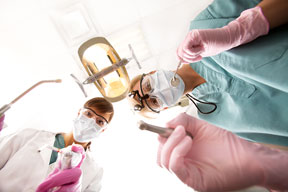 (NewsUSA)
(NewsUSA) – Sponsored News – Patient safety and infection control are key concerns among dental professionals who go to great lengths to ensure that the care they provide their patients is as effective as it is safe. With good cause, too, since research indicates that while rare, cross-infection from one patient to the next does still occur.
– Sponsored News – Patient safety and infection control are key concerns among dental professionals who go to great lengths to ensure that the care they provide their patients is as effective as it is safe. With good cause, too, since research indicates that while rare, cross-infection from one patient to the next does still occur.
According to experts, most dental offices properly sterilize their equipment in between patients, but infection-control practices do vary, and one crucial piece of equipment has continued to cause concern: the saliva-ejection valves that come into use dozens of times a day during patient treatments. These valves can be covered with millions of pathogens, including blood proteins that travel through high- and low-volume suction tips, and aerosolized saliva, although not evident to the naked eye, that coats nearby surfaces and equipment. All of this bio-burden has the potential to infect each patient that comes in contact with the valve, and you, as the consumer, have little chance of knowing whether your dentist has properly sterilized the valve in between patients. However, that doesn’t mean you can’t have some level of control. The following checklist may help alleviate concerns during your next dental visit:
* Watch the gloves. Does your dentist get gloves out of a dispenser or an unsterilized countertop? What does your dentist touch with the gloves? Do they throw the gloves away in front of you?
* Check out the office. A clean and tidy office means a greater chance for optimal infection control, because more mess makes it more difficult to sterilize countertops, surfaces and equipment.
* Ask questions and understand how risks can be avoided. One often overlooked area of concern rests with backflow, which is connected to the saliva-evacuation straw or tip that is used to remove saliva and other fluids from your mouth during dental procedures. According to the Centers for Disease Control and Prevention, 1 in 5 people who close their lips around the straw may experience backflow, or a decrease in the vacuum-line pressure that may allow previously evacuated fluid to flow backward into a patient’s mouth, potentially exposing them to germs left behind by the previous patient. However, St. Louis-based Stoma Dental may have the answer in the form of a new disposable saliva-ejector valve. The DOVE Backflow Prevention Valve is a one-way valve that prevents backflow and eliminates this possibility of cross-contamination. This new valve allows only for one-way flow or suction, and an internal flap prevents any opportunity for backflow. Because these new valves are disposable, they also can be easily replaced in between patients, alleviating concerns about germs that may land on their surface.
For more information, please visit www.besafedental.com.
Good Dental Care: Make It Safe

Featured Partner
Contributor
Font Size:

